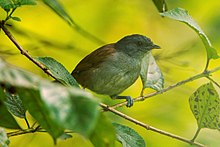| African hill babbler | |
|---|---|

| |
| In Kenya | |
| Conservation status | |
 Least Concern (IUCN 3.1) | |
| Scientific classification | |
| Domain: | Eukaryota |
| Kingdom: | Animalia |
| Phylum: | Chordata |
| Class: | Aves |
| Order: | Passeriformes |
| Family: | Sylviidae |
| Genus: | Sylvia |
| Species: | S. abyssinica |
| Binomial name | |
| Sylvia abyssinica (Rüppell, 1840) | |
| Synonyms | |
| |
The African hill babbler (Sylvia abyssinica) is a species of bird in the family Sylviidae.
Taxonomy
The African hill babbler was described by the German naturalist Eduard Rüppell in 1840 under the binomial name Drymophila abyssinica. The type locality is the Simen Mountains, northern Ethiopia.
There are currently six recognised subspecies:

- S. a. monachus (Reichenow, 1892) – Mount Cameroon
- S. a. claudei (Alexander, 1903) – Bioko Island (formerly Fernando Póo)
- S. a. ansorgei (Rothschild, 1918) – west-central Angola, southeastern Democratic Republic of Congo and western Tanzania
- S. a. stierlingi (Reichenow, 1898) – eastern and southwestern Tanzania, the Nyika Plateau in northeastern Zambia and northern Malawi and northwestern Mozambique
- S. a. stictigula (Shelley, 1903) – northeastern Zambia, northern Malawi and northwest Mozambique
- S. a. abyssinica (Rüppell, 1840) – central Ethiopia, eastern South Sudan, eastern Uganda, western and southern Kenya and northeastern Tanzania
The distinctive black-headed Rwenzori hill babbler (Sylvia atriceps) has been considered as a subspecies. Fry et al. (2000) state it has the same vocalizations and behaviour as other races, and do not give it the status of a separate species; however, Collar & Robson (2007) split them.
This species is now considered a member of the genus Sylvia.
Description
The African hill babbler is an arboreal robin-like forest bird with a thin bill, bright reddish brown back and a contrasting grey head and nape. The grey underparts are faintly marked with white streaks and the belly is paler than the breast. There is a yellowish tinge to the feathers on the flanks and the thighs. The brown eyes turn red, probably when the birds are breeding. The bill has a black upper mandible, a paler lower mandible and the legs are greyish blue. The African hill babbler weighs 14-25g and their length is 13–15 cm.
Voice
The song of the African hill babbler is a rich, melodious warble and resembles the songs of thrushes and orioles and is composed of separated whistled phrases with frequent pitch changes, and may have some scratch notes and lower pitched whistles too.
Distribution
The African hill babbler has a disjointed distribution in the highland regions of western and central Africa from southeastern Nigeria east to central Ethiopia and south to northwestern Mozambique.
Habitat
The natural habitats of the African hill babbler are montane forest and adjacent secondary forest, in dense undergrowth at forest edge and in clearings. Also found in gallery forest.
Behaviour
The African hill babbler lives in pairs which forage within 2m of the ground, gleaning insects from leaves and picking fruit. It will also feed in the canopy and will join mixed species foraging flocks. It usually keeps concealed among creepers and vines and is most often detected by voice.
References
- BirdLife International (2017). "Sylvia abyssinica". IUCN Red List of Threatened Species. 2017: e.T103872581A113116418. doi:10.2305/IUCN.UK.2017-1.RLTS.T103872581A113116418.en. Retrieved 12 November 2021.
- ^ "African hill babbler Sylvia abyssinica (Rüppell, 1840)". Avibase. Denis Lepage. Archived from the original on 2016-11-08. Retrieved 2016-11-07.
- Rüppell, Eduard (1840). Neue Wirbelthiere zu der Fauna von Abyssinien gehörig (in German). Vol. 1835–1840. Frankfurt am Main: S. Schmerber. p. 110, Plate 40 fig. 2.
- Mayr, Ernst; Paynter, Raymond A. Jr, eds. (1964). Check-list of Birds of the World. Vol. 10. Cambridge, Massachusetts: Museum of Comparative Zoology. p. 412.
- Gill, Frank; Donsker, David, eds. (2017). "Sylviid babblers, parrotbills & white-eyes". World Bird List Version 7.3. International Ornithologists' Union. Retrieved 7 September 2017.
- ^ "African Hill Babbler (Pseudoalcippe abyssinica)". Handbook of the Birds of the World. Lynx Edicions. Archived from the original on 2016-09-13. Retrieved 2016-11-07.
- ^ Borrow, Nik; Demey, Ron (2001). Birds of Western Africa. A & C Black. p. 679. ISBN 0-7136-3959-8.
- ^ Zimmerman, Dale A.; Turner, Donald A.; Pearson, David J. (1996). Birds of Kenya and Northern Tanzania. Helm. p. 530. ISBN 0-7136-3968-7.
- Sinclair, Ian; Ryan, Peter (2003). Birds of Africa south of the Sahara. Struik. p. 408. ISBN 1-86872-857-9.
- Collar, N. J. & Robson, C. 2007. Family Timaliidae (Babblers) pp. 70 – 291 in; del Hoyo, J., Elliott, A. & Christie, D.A. eds. Handbook of the Birds of the World, Vol. 12. Picathartes to Tits and Chickadees. Lynx Edicions, Barcelona.
- Fry, C. H., S. Keith, and E. K. Urban. 1988. The Birds of Africa. Vol. 3. Academic Press, London.
External links
| Taxon identifiers | |
|---|---|
| Sylvia abyssinica | |
| Pseudoalcippe abyssinica | |